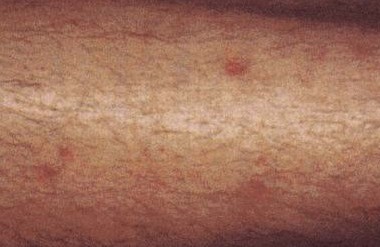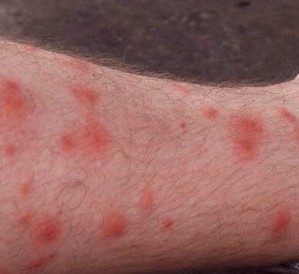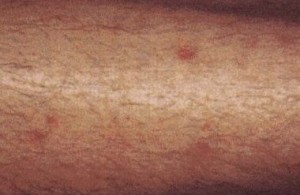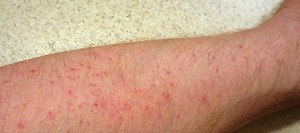Itchy bumps on legs may occur due to a variety of causes. Poor hygiene is one of the main culprits. Presence of old skin cells and dried sweat for prolonged periods can be the perfect breeding ground for bacteria, fungi, and other germs thereby causing inflammation and itchy bumps on legs. Infectious diseases and varied dermatitis types are other well-known causes.
A few common causes of itchy bumps on legs along with the associated symptoms are listed below:
- Contact dermatitis: It is a skin condition which occur due to contact of the skin with certain allergens or irritants. The immune system considers such irritants as being harmful for the body and causes a reaction which is marked by development of itchy red bumps on legs.
- Some of the common skin irritants include poison ivy, poison oak, and chemicals present in detergents, soaps, perfumes, and cosmetics.
- The characteristic symptom of contact dermatitis is the development of blistering on that part of the leg which got exposed to the irritant. The condition is generally diagnosed via a patch test.
- Atopic dermatitis: It is the most widespread form of eczema and is usually just known as eczema. Affected individuals may suffer from scaling, extreme itchiness, peeling of the upper skin layer, inflammation, and Itchy bumps on legs.
- Lichenification may occur in patients with chronic atopic dermatitis. It is marked by thickened skin that develops elevated lines in a crisscross pattern.
- Children are mostly affected by this atopic dermatitis, wherein the bumps occur on the feet and ankles. Affected adults and teens may develop itchy bumps on the back portion of the knees.
- Discoid eczema: This form of eczema is usually found to occur in adults. It normally affects the legs but can also occur in any other part of the body.
- Patients may experience the formation of patches on skin that are very itch and which later turn sore. The patches tend to be oval or slightly square-shaped with clear borders. They are vulnerable to infection by bacteria and hence need to be immediately treated.
- Prurigo nodularis: It is a skin condition marked by development of crusty, hard, itchy bumps on legs.
- The bumps are very itchy and can grow up to 1 to 3 cm diametrically. They tend to be itchy continuously, especially during night or after contact with hands or clothes. The itchiness may occasionally cease only when the affected area is scratched so vigorously that it starts bleeding and/or becomes painful.
- Varicose eczema: Also called gravitational eczema, the disorder develops due to inefficient transportation of de-oxygenated blood from the legs to the upper part of the body. Such inertia of the blood in the veins leads to the formation of ulcers, lesions, and itchy bumps on legs. Sometimes, open sores may also develop on the legs, particularly near the ankles.
- Psoriasis: It is an autoimmune disease facilitated by T lymphocytes or T cells and marked by the occurrence of inflamed, symmetrical, and scaly plaques that burn and itch. The knees and shins are usually affected by psoriasis skin plaques.
- Psoriasis associated itchy bumps on legs rarely affects dark-skinned individuals; it mostly occurs in fair-skinned people.
- Athlete’s foot: Also called tinea pedis, athlete’s foot is an infectious condition that normally occurs on the feet. It develops due to infection by fungi from the genus Trichophyton.
- In addition to itchy bumps on legs, patients may suffer from flaky or scaly skin along with pain. Some affected people may also experience blisters and inflammation. It is possible for the infection to migrate to other areas of the body.
- Scabies: It is caused due to infection by Sarcoptes scabiei mites which burrow and then live in the skin. Scabies is a contagious disease and is marked by development of red, itchy blotches on the skin; the itchiness is more severe at night.
- Any area of the body can get affected by scabies, but it commonly occurs in the area between the fingers and toes, and on the elbows and knees.
- Cellulitis: This skin condition is another common cause of itchy bumps on legs. It is caused due to infection by external bacteria or by bacteria which naturally occur on the skin. Overgrowth of the bacteria can then inflame the layers of the skin, thereby causing painful and itchy rashes on the skin.
- Cellulitis can affect any part of the body, but it is most commonly found on the face and the lower sections of the legs. People with cuts, wounds, cracks, and/or blisters on the skin as well as those with an impaired or weakened immune system are more likely to develop cellulitis.
- Other causes: Other common causes of itchy bumps on legs are hives, folliculitis, keratosis pilaris, insect bites, shingles, and dermatitis herpetiformis.
Treatment of itchy red bumps on legs
Treatment for itchy bumps on legs is dependent on diagnosis of the underlying causative disease and curing it as per the set medical procedures for each of them.
Some home remedies include:
- Following good personal hygiene.
- Drinking lots of water, eating a healthy and balanced diet, and regular exercising.
- Regular exfoliation of the skin.
- Application of cucumber juice, clarified butter, or milk on the affected parts of the legs.
- Soaking the legs in a solution of water and oatmeal, baking powder, or cornstarch.
Itchy bumps on legs (pictures)



